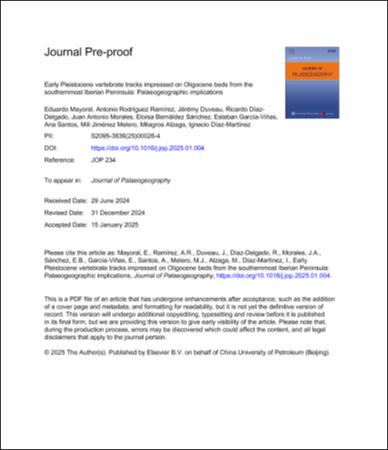
.jpg)
REPOSITORIO DE ACTIVOS DIGITALES
Depósito de documentos digitales reúne, difunde y preserva la documentación generada en los proyectos y actividades del Instituto Andaluz del Patrimonio Histórico.
https://hdl.handle.net/11532/380311
| Campo DC | Valor | Lengua/Idioma |
|---|---|---|
| dc.contributor.author | Mayoral Alfaro, Eduardo | es_ES |
| dc.contributor.author | Rodríguez Ramírez, Antonio | es_ES |
| dc.contributor.author | Duveau, Jérémy | es_ES |
| dc.contributor.author | Díaz-Delgado, Ricardo | es_ES |
| dc.contributor.author | Morales, Juan Antonio | es_ES |
| dc.contributor.author | Bernáldez Sánchez, Eloísa | es_ES |
| dc.contributor.author | García-Viñas, Esteban | es_ES |
| dc.contributor.author | Santos, Ana | es_ES |
| dc.contributor.author | Jiménez Melero, Mili | es_ES |
| dc.contributor.author | Alzaga García, Milagros | es_ES |
| dc.contributor.author | Díaz-Martínez, Ignacio | es_ES |
| dc.coverage.spatial | Tarifa | es_ES |
| dc.date.accessioned | 2025-02-09T10:50:47Z | - |
| dc.date.available | 2025-02-09T10:50:47Z | - |
| dc.date.issued | 2025-01 | - |
| dc.identifier.issn | 2524-4507 | es_ES |
| dc.identifier.uri | https://hdl.handle.net/11532/380311 | - |
| dc.description.abstract | The southern of the Iberian Peninsula preserves a diverse ichnological record of vertebrates from the late Neogene–Quaternary. While the ages of several tracksites, such as those from the Miocene–Pliocene transition and the middle-late Pleistocene, are well-established, others remain undated or have unknown ages. This paper reports the discovery of the southernmost tracksite in the Iberian Peninsula and continental Europe on the Island of Tarifa (Cádiz). The tracksite contains over 600 vertebrate footprints from the early Pleistocene that are grouped in four morphotypes. Morphotypes 1, 2 and 3 are predominantly didactyl-shaped, rounded to ovoid and elongated, and associated with tracks left by artiodactyls. Morphotype 4, suboval to subcircular in outline, is the largest and is probably related to the imprint left by proboscideans. We also document the progressive transition from morphotype 2 with isolated, rounded footprints to morphotype 3 with elongated tracks formed by overlapping two tracks of the same animal which is observed. The consistency of the substrate, together with the trackmaker limb dynamics, conditioned the final morphology of the tracks, which were produced in a very soft clay-rich substrate of late Oligocene, that was folded and tilted in the latest Pliocene. This relief configuration gave rise to a narrow, partially or totally flooded corridor through which the trackmaker animals passed continuously, simultaneously, and in opposite ways. This discovery from the southernmost tip of continental Europe is the first one from the early Pleistocene in the Iberian Peninsula and a rare example from the Mediterranean region. | es_ES |
| dc.format | es_ES | |
| dc.language | Inglés | es_ES |
| dc.language.iso | eng | es_ES |
| dc.publisher | Elsevier B.V. | es_ES |
| dc.relation.uri | https://guiadigital.iaph.es/bien/inmueble/28181 | es_ES |
| dc.rights | © Instituto Andaluz del Patrimonio Histórico | es_ES |
| dc.rights.uri | http://creativecommons.org/licenses/by-nc-sa/3.0/deed.es | es_ES |
| dc.source | Journal of Palaeogeography | es_ES |
| dc.subject | Icnología | es_ES |
| dc.subject | Artiodáctilos | es_ES |
| dc.subject | Huella | es_ES |
| dc.subject | Costa | es_ES |
| dc.subject | Paleogeografía | es_ES |
| dc.subject | Geomorfología | es_ES |
| dc.subject | Vertebrados | es_ES |
| dc.subject | Pleistoceno | es_ES |
| dc.title | Early Pleistocene vertebrate tracks impressed on Oligocene beds from the southernmost Iberian Peninsula: Palaeogeographic implications | es_ES |
| dc.type | info:eu-repo/semantics/article | es_ES |
| dc.coverage.placename | Península Ibérica | es_ES |
| dc.coverage.placename | Andalucía | es_ES |
| dc.coverage.placename | Estrecho de Gibraltar | es_ES |
| iaph.bien.denominacion | Espacio Subacuático Isla de Tarifa (28181) | es_ES |
| iaph.disponibilidad.externo | Consulta, reproducción, uso público | es_ES |
| iaph.disponibilidad.interno | Consulta, reproducción, uso público | es_ES |
| dc.relation.publisherversion | https://www.sciencedirect.com/science/article/pii/S2095383625000264 | es_ES |
| iaph.provincia | Cádiz | es_ES |
| dc.identifier.doi | https://doi.org/10.1016/j.jop.2025.01.004. | es_ES |
| dc.rights.accessrights | info:eu-repo/semantics/openAccess | es_ES |
| Aparece en las colecciones: | Artículos en publicaciones seriadas | |
| Fichero | Descripción | Tamaño | Formato | |
|---|---|---|---|---|
| Early Pleistoc.Mayoral_2025-1_compressed.pdf | 2,85 MB | Adobe PDF |  Ver |
Los ítems de IAPH están protegidos por copyright, con todos los derechos reservados, a menos que se indique lo contrario.
Exportar registro
Ítems relacionados
Domínguez Castillo, Carmen; Jiménez Hidalgo, María; López Gámez, José; Rodríguez Hortal, Ana; Alzaga García, Milagros; Gallardo Abárzuza, Mercedes; Higueras-Milena Castellano, José Manuel; Gomez-Moron, María Auxiliadora; García-Viñas, Esteban; Bernáldez Sánchez, Eloísa; Martínez Haya, Bruno
Gamero-Esteban, Miguel; Bernáldez Sánchez, Eloísa; García-Viñas, Esteban; Higueras-Milena Castellano, José Manuel; Gallardo Abárzuza, Mercedes; Alzaga García, Milagros; Gomez-Moron, María Auxiliadora
Alzaga García, Milagros; Gallardo Abárzuza, Mercedes; Higueras-Milena Castellano, José Manuel; Bernáldez Sánchez, Eloísa; García-Viñas, Esteban; Domínguez Delmás, Marta; Guijo Mauri, Juan Manuel; Cornellá, Anna; Leonard, Jennifer A.
Bernáldez Sánchez, Eloísa; Mayoral Alfaro, Eduardo; Santos, Ana
Muñiz Guinea, Fernando; Mayoral Alfaro, Eduardo; Santos, A. Miguel P.; Martín, M.; Bernáldez Sánchez, Eloísa








